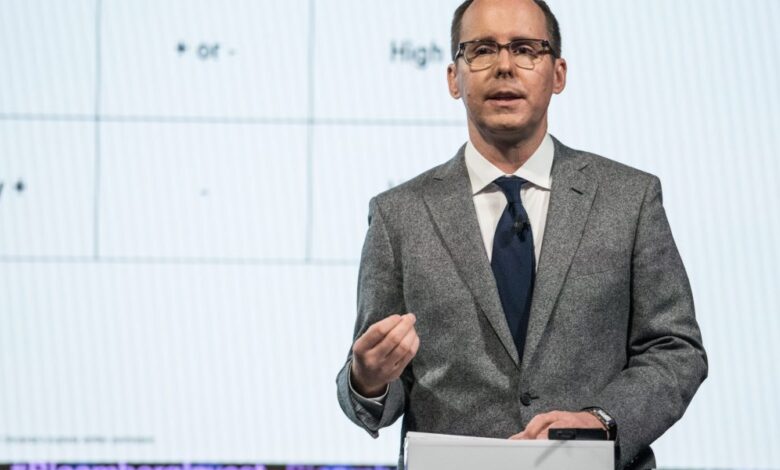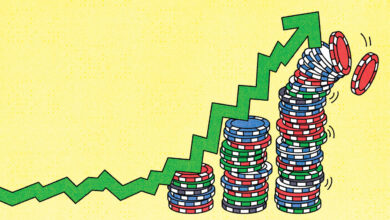‘Black Swan’ hedge funder Mark Spitznagel insists he’s no permabear: ‘Cassandras make terrible investors’

Mark Spitznagel has developed a reputation as a pessimist over the years. But it’s a distinction the co-founder and CIO of the private hedge fund Universa Investments has earned for good reason. When you warn, time and again, that the Federal Reserve has helped blow up the “greatest credit bubble in human history” and all bubbles eventually pop, investors—and the media—will tend to focus on the bearish part of your outlook. Plus, Spitznagel’s patented strategy, called tail risk hedging, seeks to profit from sharp market downturns, and he’s employed Nassim Taleb, the statistician and academic who popularized the concept of the rare and unexpected event called a “black swan,” as a “distinguished scientific advisor.”
Nevertheless, Spitznagel says he’s a bit misunderstood, and so is his strategy. Tail-risk hedging is meant to protect investors when things go wrong—an “insurance policy” of sorts, the Wall Street veteran tells Fortune—but the real value of that is it enables Universa’s clients to invest more of their portfolios in stocks with price appreciation potential; to take on more risk, not less. As Spitznagel put it, “the entire point of it is that they can be longer.”
Still, most media headlines about Spitznagel, including ours here at Fortune, tend to focus on his bearish forecasts. And while there’s a clear reason for that—after all, Spitznagel recently told Business Insider that he believes the “worst market crash since 1929” is coming—the hedge funder has indeed been bullish in recent years. He argued in his 2023 investor letter, seen by Fortune, that a stock market rally was coming, and has said publicly on multiple occasions that until the Fed starts slashing rates, markets will likely keep rising.
“I’ve talked with a couple of people and it always comes away that I’m some permabear. Which is fair, because my entire life I’ve been skeptical…of monetary interventionism and just the destructiveness that it has on investors, on the economy, and on capital,” Spitznagel said. “But at the same time, clearly, I’m not a permabear. I’ve been as positive on this market as I could possibly have been in the last year and a half.”
Even now, after a nearly 10% year-to-date run for the S&P 500, Spitznagel remains, let’s say, cautiously bullish. With the Fed putting its rate hikes on pause in July 2023 and corporate announcements around AI receiving all kinds of hype, markets have been in a sentiment-induced “Goldilocks zone,” according to the hedge funder. “And we have a bit more to run on this,” he told Fortune.
The Goldilocks zone
Despite his concerns about the long-term impact of our rising national and private debts, and the lagged impact of the Fed’s rate hikes on the economy, Spitznagel argued that investors are ignoring these negatives and driving markets higher for now. That’s because “sentiment was so bad in ‘22, we thought we’re in the ‘70s, and that sentiment had to flip both in the markets and even in the economy,” he said.
For Spitznagel, the current stock market rally is simply based on a relatively dovish Fed and bullish investor sentiment, “both of which are just basically juice.”
But like any Goldilocks zone, this one won’t last forever. Investors’ positive sentiment alone can’t carry markets higher indefinitely; fundamentals like earnings and economic growth will eventually become relevant. And Spitznagel still believes that higher interest rates are weighing on the economy, which means the fundamentals won’t hold together forever.
“The Fed did a lot. And now it’s sort of jawboning its way out of it. But it can’t take back what it did,” he said. “Markets follow fundamentals at the end of the day, but you can have these little Goldilocks zones where it can get sort of untethered.”
We may be in a Goldilocks zone now, but when the Fed starts cutting interest rates, which many on Wall Street expect to happen this year, Spitznagel argued that it will be a sign that the economy is feeling the weight of years of rising borrowing costs in an era of surging public and private debts.
The fallout from the “the fastest, greatest tightening ever, by some regards, into the greatest credit bubble of human history” can’t be avoided, he added, arguing “that’s when things are going to be really bad—and at that point, it’s probably also too late to get out.”
Ok, but what about being bullish? I thought Spitznagel said he was bullish? And yes, “again, I’m sounding like a permabear right now,” the hedge funder admitted.
But with AI hype growing and the Fed “sort of apologizing” for raising interest rates so aggressively ever since it paused its hikes last July, according to Spitznagel, we are in one of “these zones where everything feels really good, where there’s sort of this middle ground.” So he’s at least bullish in the near-term, even if he still fears a crisis could hit at some point.
But remember: ‘Cassandras make terrible investors’
In Greek mythology, Cassandra was a princess of Troy who had the curse of being able to see the future—but not being believed by anyone she warned. (This was particularly fateful in her warning to the Trojans that the famous horse the Greeks gave them was not a gift, but a trick.)
Investors reserve the term “Cassandra” for those who make prophetic forecasts that are ignored by the masses. But the thing is, when it comes to managing money, those who purely preach doom and gloom, without understanding the power of the markets and the American economy over the long term, don’t end up doing too well, according to Spitznagel.
“I can’t say this strongly enough: Cassandras make terrible investors,” the hedge funder said, repeating himself for emphasis and adding: “with no exception.”
The comment, which might be seen by some as a critique of fellow hedge funder Michael Burry of Big Short fame, who goes by Cassandra B.C. on X, is admittedly a bit odd coming from Spitznagel—a man who, again, has warned just this past year about “the greatest credit bubble in human history” and “the worst market crash since 1929.”
But at the same time, Spitznagel does always stick to one of Warren Buffett’s key bullish principles: Don’t bet against America. The Wall Street veteran said that—even with a brewing debt crisis and mounting odds of a stock market crash—over the long term, American businesses will continue to innovate and expand. “You can be very, very long term positive, but understand nevertheless that there are crises ahead,” he explained.
Spitznagel believes investors would only hurt themselves by trying to time market entries and exits. And he warned that professional investors who tell the masses to flee stocks often do so at the worst possible time. These doomsayers have the luxury of being able to wait a long time for a payoff, but most Americans don’t have that time or capital.
Now, as investors’ euphoria over AI continues to grow, Spitznagel said that “what’s going to end up happening is all those Cassandras are going to finally buy into this market at the highest, which probably isn’t too far away.”
Too often, he said, investors end up buying at market highs, and then selling when there’s a crash. Instead of that, Spitznagel recommends the average investor keep some extra cash on hand, ensuring that when there is a market dip, it won’t force them to sell at the worst moment.
If all you do is buy and hold the largest American businesses, a market crash is merely an opportunity to load up for the long term, he argued. Even the reputed permabear who fears a debt crisis is coming believes the best option for the average investor is to simply buy and hold the S&P 500 for the long haul, adding to your position when the market falls.
“If I was only allowed to make one trade for the next 20 years, and I had to do it today, and I [could] not touch a portfolio for 20 years, I would buy the S&P [500],” he said. “Because remember: Cassandras make terrible investors.”





